Wild Cucumber – (Echinocystis lobata) – Good or Bad?
This post may contain affiliate links. Read my full disclosure here.
Wild Cucumber (Echinocystis lobata) festoons the landscape with fragrant flowers from midsummer into fall. We’ll share photos and tips for identification, and answer some common questions about this rowdy wild neighbor.
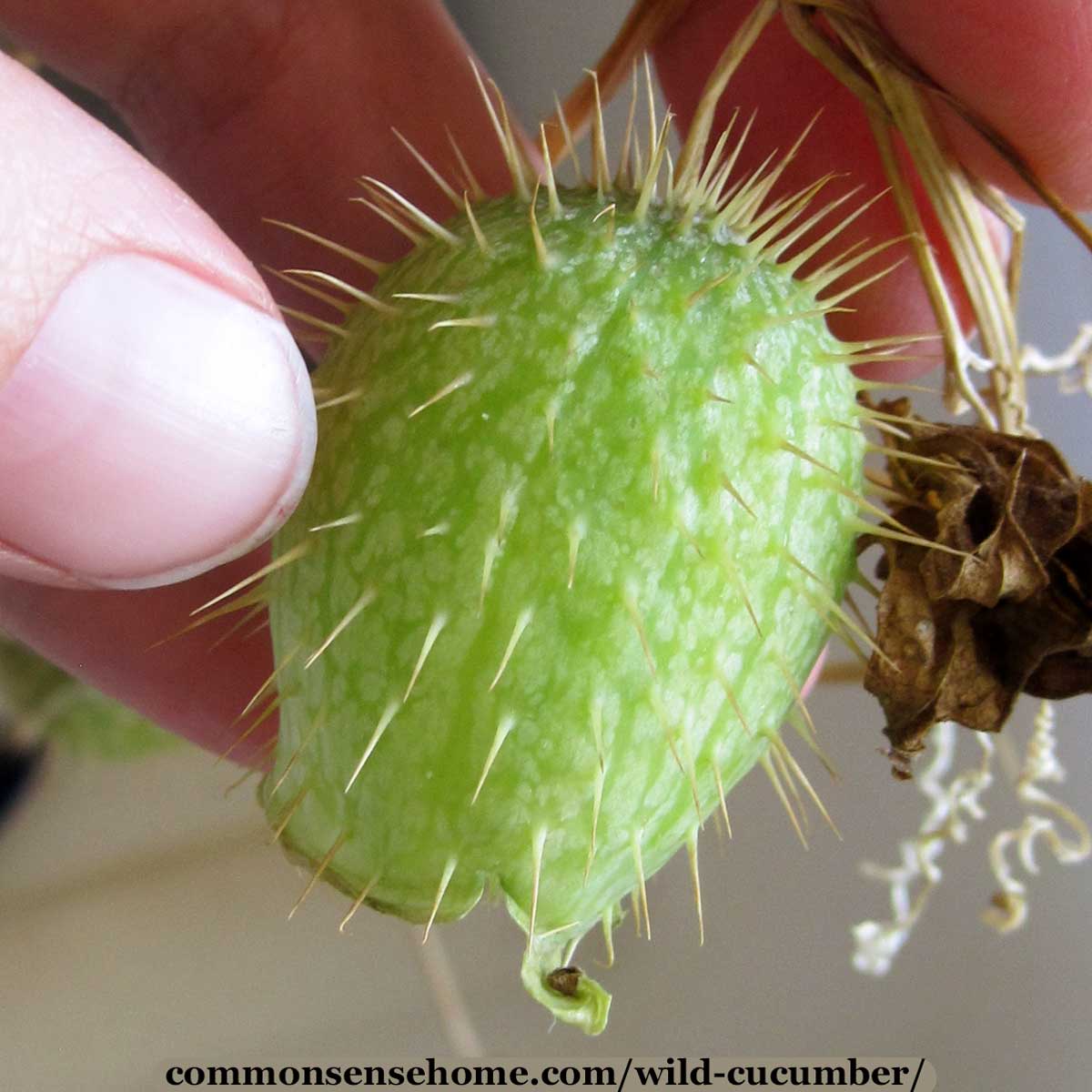
Wild cucumber is also known as Balsam Apple, Prickly Cucumber, Wild Balsam Apple, Wild Mock Cucumber and Lace Pants.
Plant Photos and Identification
Echinocystis lobata is an annual vine, setting fruit that resemble small, prickly cucumbers. It’s a member of the gourd family (Cucurbitaceae). They look similar to bur cucumbers (Sicyos angulatus).
They are not closely related to garden cucumbers, Cucumis sativus, although we did once find a cucumber beetle in one of the fruits.
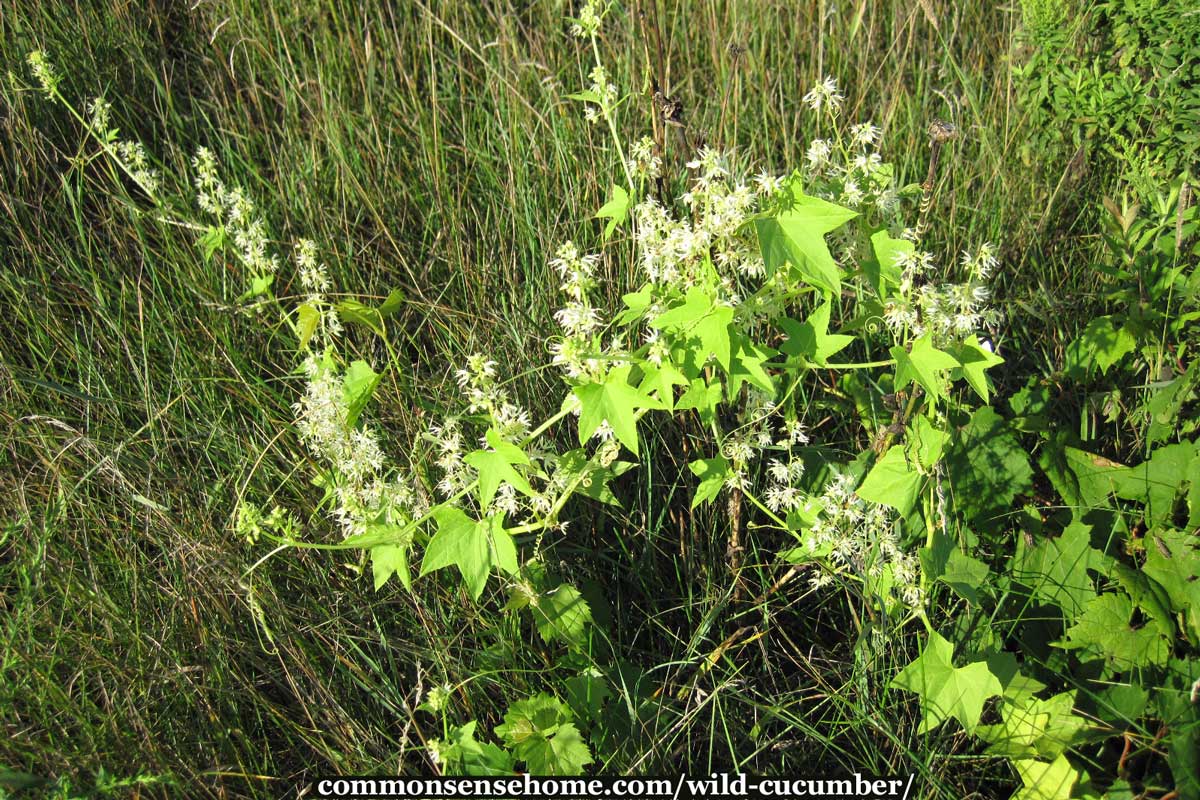
It prefers wet areas with some shade, including deciduous woods. We normally find it growing in low lying parts of our prairie area. In wet years, it cascades along fence lines and roadsides.
Vines
Wild cucumber vines can grow up to 25-30 feet long. The large leaves have five palmate lobes, resembling maple leaves in shape.
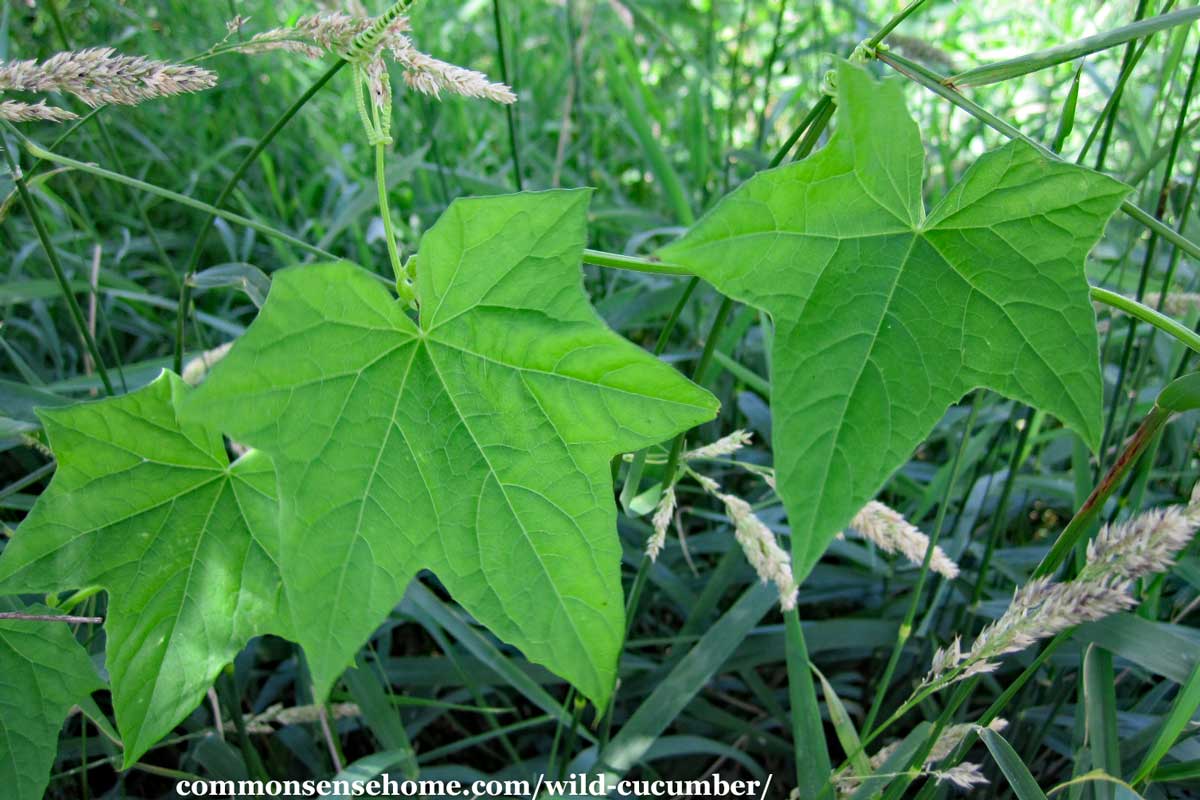
The stem is square, and like garden cucumbers, its tendrils coil outward from the leaf axils to allow the plant to grasp and climb. It readily overgrows trees and shrubs, but rarely does serious damage.
Flowers
Flowers appear from mid-summer into fall and are small, white and very fragrant. Wild cucumbers have separate male and female flowers on the same plant. They are self-fruitful.
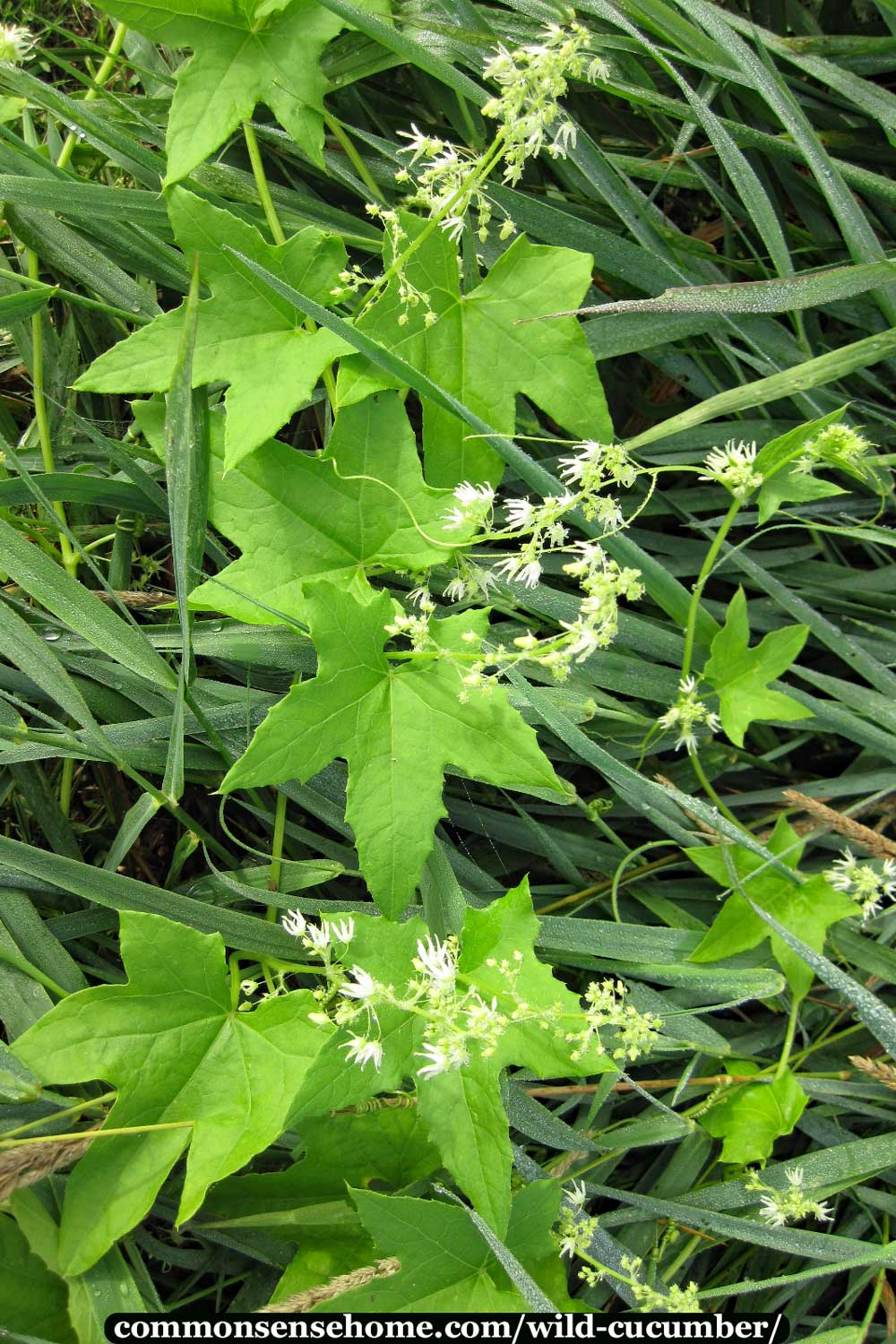
Fruit
The fruit of the wild cucumber is a single, large, spiny pod-like container, roughly 2″ (5 cm) long. There are four large seeds in individual chambers.

As it ripens, the fruit dries to a paper-like husk, which opens at the bottom to eject the seeds. The name “lace pants” comes from the appearance of the dried fruit.
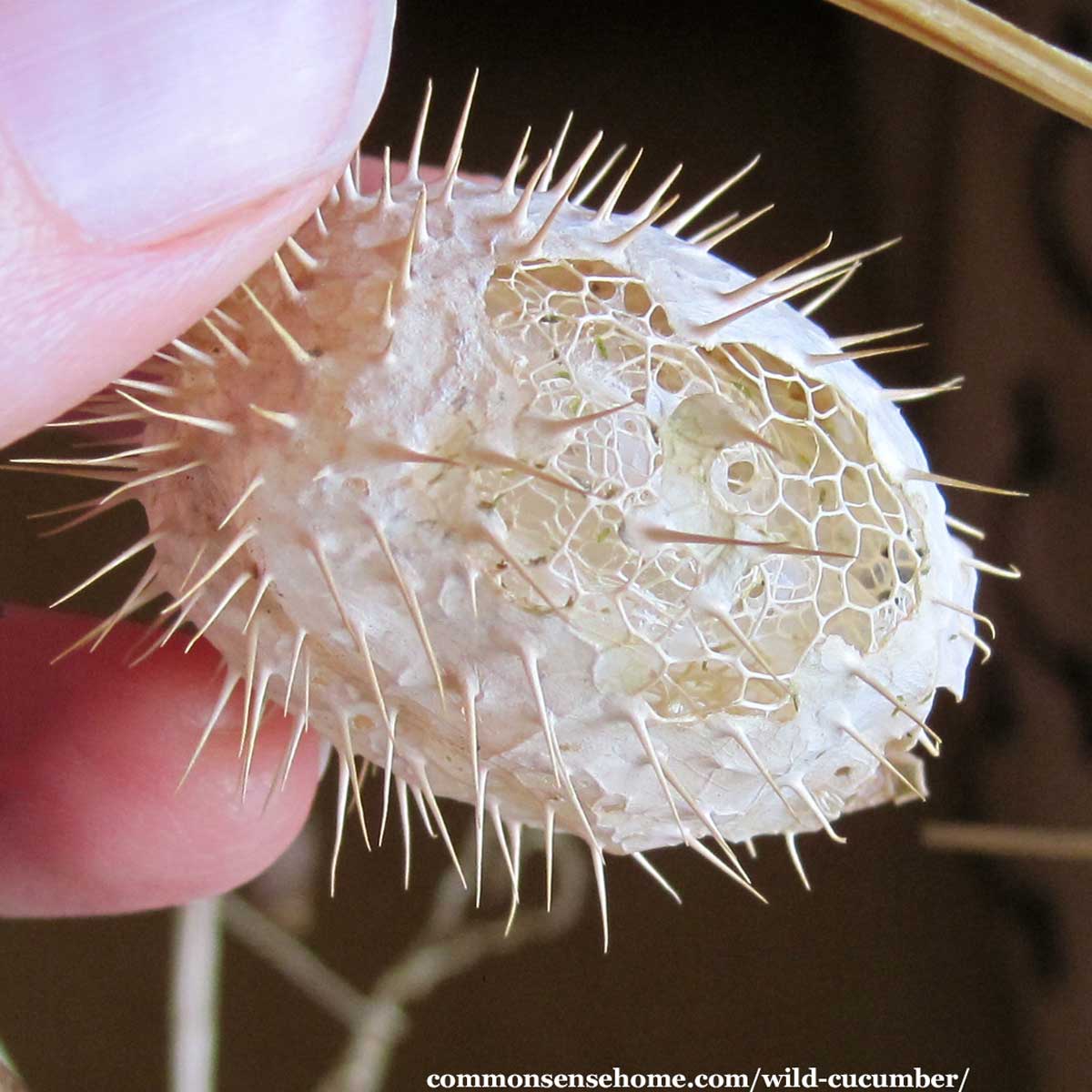
(See Wildflowers Of Wisconsin for more information.)
Are wild cucumbers safe to eat or poisonous?
While they may look and smell like garden cucumbers, wild cucumber fruit is not safe to eat. It causes stomach upset, diarrhea, and even burning reactions for some people. Handle the fresh fruit with caution.
Are wild cucumbers poisonous to dogs, too?
Yes. Don’t let curious pets eat the fruit.
Would you like to save this?
What is wild cucumber good for?
The flowers of wild cucumber smell wonderful (at least to me), and the fruit is ornamental. Some people train the vines over a fence or pergola.
Illinois Wildflowers states that the wild cucumber flowers are visited by several species of bees, flies and wasps. I have not found any reference to wildlife eating the seeds, but they have been used as beads.
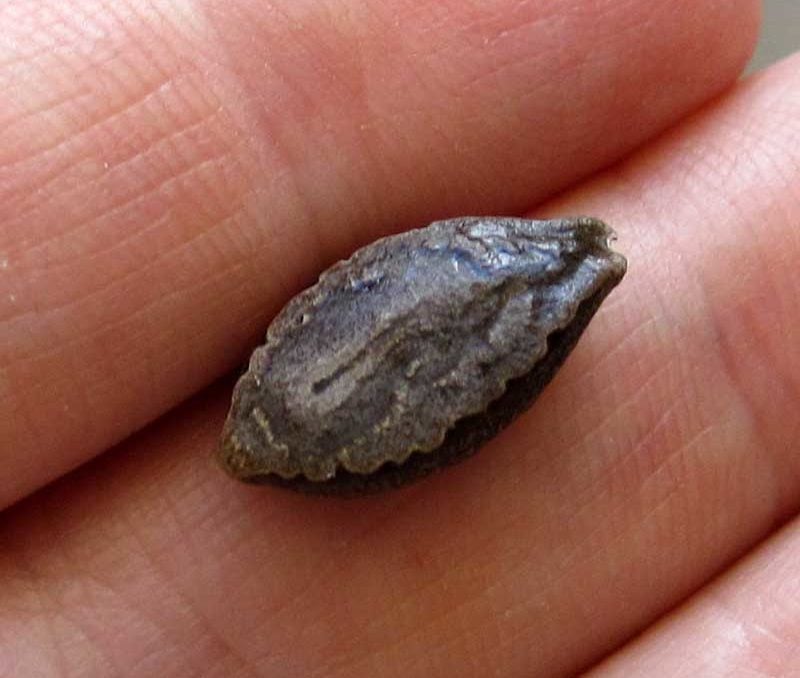
Is wild cucumber invasive?
While fast growing – the vines can reach 30 feet in a season – the vines are native to North America. They are not an invasive species in the U.S. and Canada.
That said, they can grow crazy fast and smother trees and shrubs. If you don’t want wild cucumber in an area, it’s best to pull or cut the plants when they are small. Don’t let the fruits mature, or they will open up and spread more seeds.
Medicinal Uses of Echinocystis lobata
Peterson’s Field Guide to Eastern/Central Medicinal Plants and Herbs states:
American Indians used the extremely bitter root tea as a bitter tonic for stomach troubles, kidney ailments, rheumatism, chills, fevers, and obstructed menses. Also used in love potions and as I general tonic. Pulverized root poultice for headaches.
This post is for informational purposes only and is not intended to treat or diagnose any illness. Always exercise caution when using any wild plants and make sure you have positively identified the plant.
This post is #37 in the Weekly Weeder Series.
More Wildcrafting and Foraging Information
Recommended Resources:
You may also enjoy other posts in the Weekly Weeder Series and Herbs and Wildcrafting, including:
- Recommended Wildcrafting Reference Books
- Chicory – The Coffee Root Plant – Weekly Weeder #5
- Benefits of Dandelion, Plus How to Use Greens, Seeds, Roots & Flowers
For more in depth plant studies, consider The Herbal Academy.
They have a Botany and Wildcrafting Course that covers in depth information on 25 common wild plants.

Please Like, Pin or otherwise share this post if you would like the Weekly Weeder series to continue.
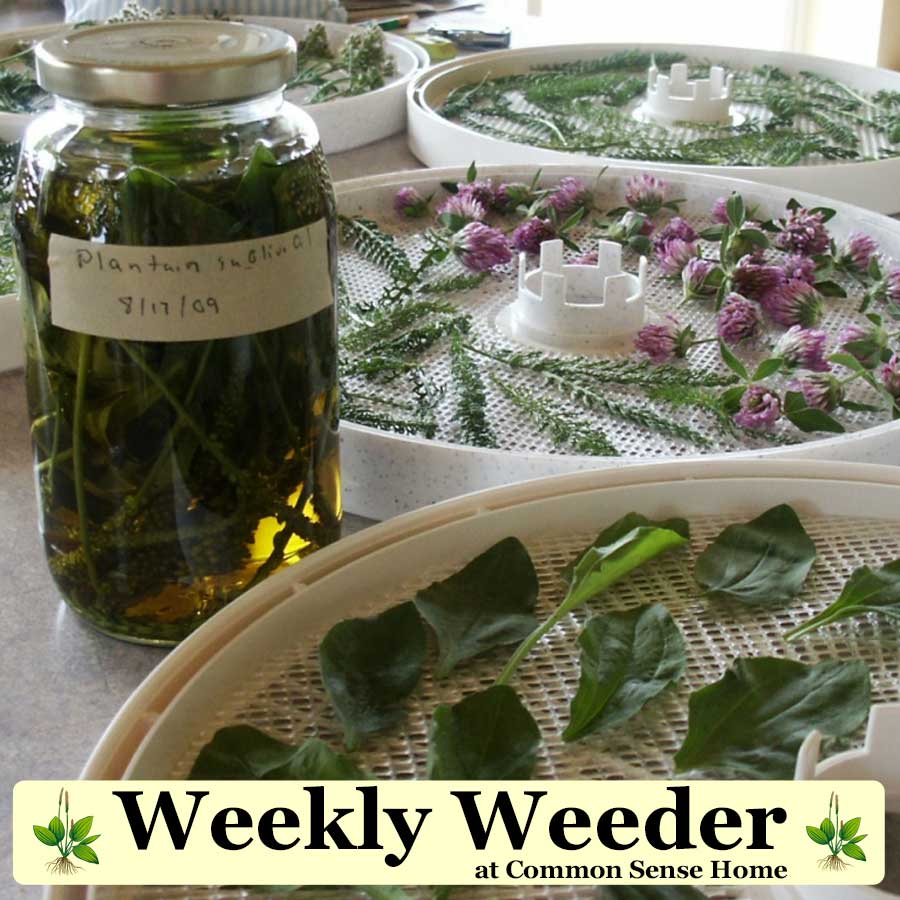
Originally posted in 2012, last updated in 2020.

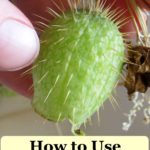
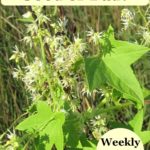
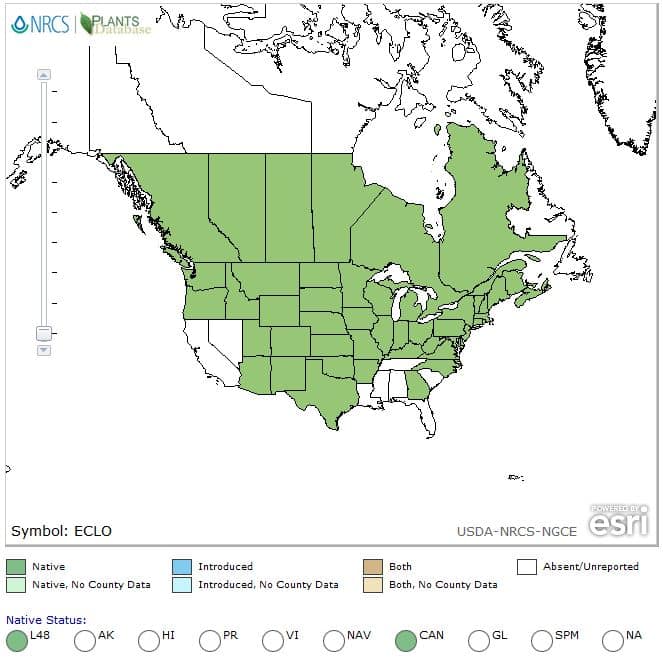
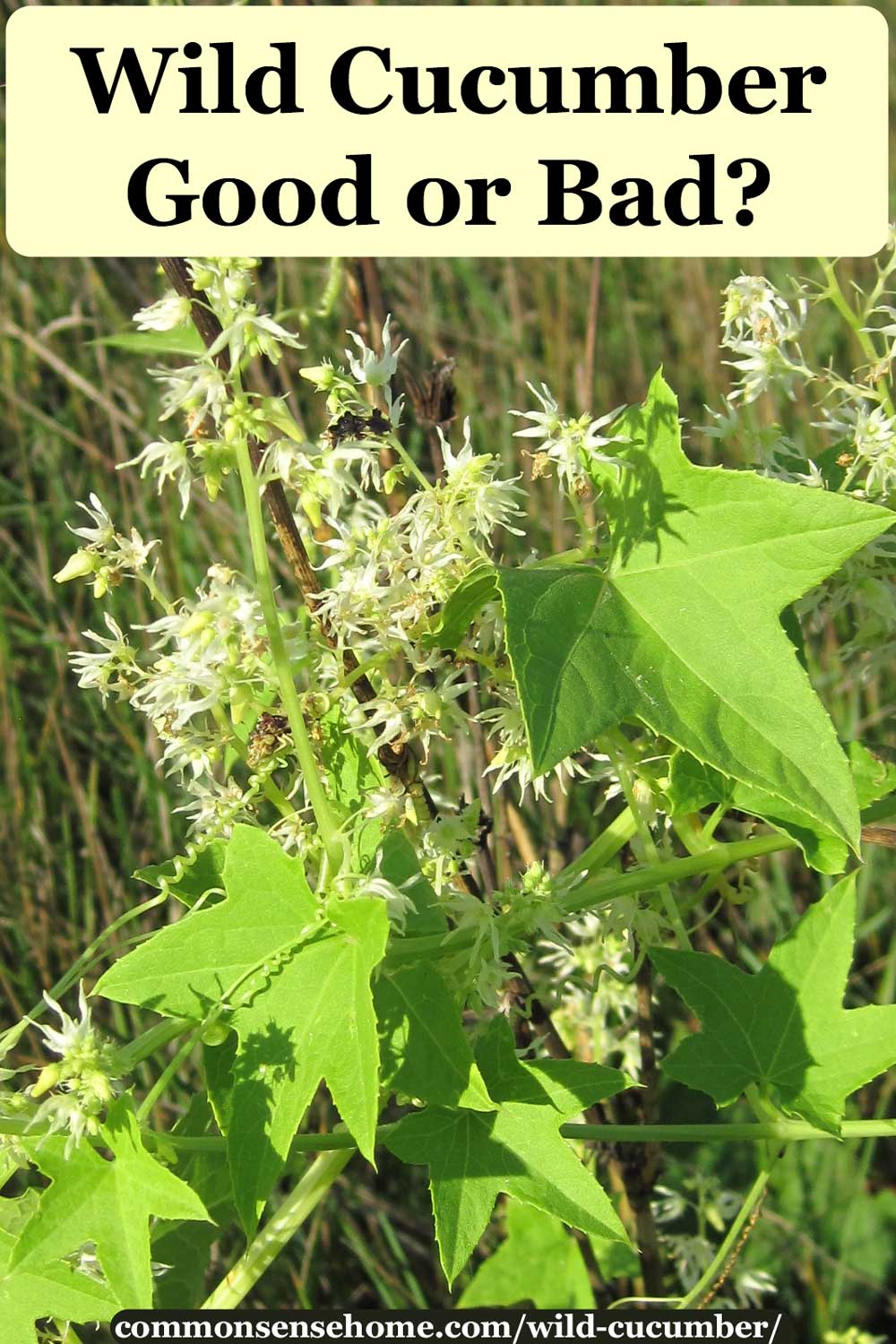
my dog has a sore on his foot between his toes. checked the yard and found some wild cucumber pods on the ground. if he stepped on one of these could it cause a sore. he licks it and it seems to be getting better then he starts licking again and seems to get sore again.
If the wound isn’t healing, you should check to see if something is still embedded. Normally, even if it was punctured by something spiky like the pods, it would heal. The fact that it’s not healing has me concerned. If you can’t find anything, I’d seriously consider getting it checked by a vet. The pods should not cause a wound that won’t heal, unless a spine is still embedded.
This is interesting! I’m finding this well after conducting my own experiment, because I couldn’t find anything about them at the time. But I gathered a bunch of the fruits, removed the seeds, and boiled the fruits, let them soak over night in the same water, then removed the fruits and made jelly from the water, which involved more boiling on high heat for it to set. It was one of the best jellies I ever made, beautiful light golden colour and refreshing gentle sweetness. I’ve had no adverse reactions any of the times I’ve eaten it and nor has anyone else whom I’ve shared it with.
Maybe a lot of boiling neutralizes the poison? Or maybe that in combination with the fact that I and others I shared it with only ate half a bagel or a few crackers with it on. So seed removal + boiling + removing the actual fruit and leaving only the juice + more boiling + not eating very much of it = edibility? I know that seems like a lot of processing and some might question whether it’s worth it, but honestly the jelly was fantastic and I would do it again should I find the fruits in abundance like I did that time. But it’s good to know that in general the fruits are poison. Definitely won’t be doing anything with it that doesn’t involve thorough cooking.
I know that cooking can break down some problematic compounds, like the glycosides in elderberries, so perhaps it’s the same with wild cucumber. I would consume with caution and in small amounts, but appreciate you sharing your experience.
I wonder about other wild plants in the yard. There’s jewel weed which grows right next to the poison ivy and is actually the antidote to it. There seems to be an orange flower and a yellow flower variety. Ther is what is called pokeberry that I wonder about. Is there anything on wildflower remedies? I see the thing on poisonous plants. Not sure if it is the same thing.
I’m not sure I understand the question.
Yes, jewelweed can be found in yellow and orange variations, and often grows near plants that cause irritation, like poison ivy or stinging nettle.
I don’t have an article on pokeweed on the site yet, because I haven’t spotted any on our land or nearby. I know poke leaves and shoots were eaten as a cooked spring green. The berries can be eaten if cooked. There is some risk to eating the plant.
Ohio State University notes:
I had the great idea of pulling off all the wild cucumber pods and covered the picnic table with them. Could have covered the two benches as well, but the Mrs. didn’t see the fun in it as I did. Now the idea is just control the spread to areas I don’t want them. I took them away before they matured, so I stand a chance for success. Did you also notice they contain a sort of oily residue in them? What’s with that?
I haven’t handled them much, since they grow in the more wild areas of the property. The only oil reference I readily found was from The Nature Collective, which noted: “The oil from the seeds was often used to reverse baldness; chemicals in wild cucumber have pharmacological activities similar to chemicals used in modern baldness treatments.”
So I ate a bite of a fruit tasted terrible and spit it out right away yesterday, today my stomach hurts real bad and and cant eat, what can I do to make the symptoms go away? If there is anything,? Again I didn’t swollow anything but tummy hurts so bad!!
I take it you read the “not safe to eat” part of the post after it was too late?
Given that eating it is not advised, I haven’t heard of anyone treating the result.
Some options I would consider:
Charcoal capsules, to absorb any residual toxins.
Plantain, externally and internally, for the same reason, and to draw down inflammation. That’s plantain the weed, not the banana-like thing. You may be able to find it growing in your yard or garden.
You can check out plantain remedies here – https://commonsensehome.com/grandma-called-it-medicine-leaf/
Can humans eat the leaves? I ate a small one. It was very sweet. Absolutely delicious and had no adverse reaction. That said it was only the size of 3 quarters.
According to a comment on the Minnesota wildflowers website post about wild cucumber, leaves and growing tips are edible.
You can dry the larger ones and use them as a loofah Sponge for the bath.
Ours don’t get much bigger than a couple inches long. Do they grow larger in your area?
I’m in Southern California and most of the pods get to be the size of baseballs – smaller on younger vines but on the ones that come back year after year they are really big. My goats and sheep will eat the leaves and they don’t seem to bother them
As I understand it, only the seeds are a potential problem.Thanks for sharing your experience.
will they kill dairy cows if eaten?
I haven’t found wild cucumber listed in the dozen or so lists of plants toxic to cattle that I searched. Usually they will avoid a plant that’s toxic, unless there is absolutely nothing else to eat.
why are there so many this year they are all over what can I do to get rid of them?
I’ve noticed that the wild cucumbers are abundant in our area this year, too. I’ve seen more this year than any year I can remember. They seem to like the weather. Lots of goldenrod this year, too.
The plant is an annual, so it must start new from seed each year. If possible, cut it back or pull it before it seeds out. Most weed seeds can persist in the soil for years, even decades, waiting for the right conditions to germinate and thrive. This was that year for wild cucumber.
You can use commercial or homemade weed control sprays or other options (https://commonsensehome.com/natural-weed-control/), but they will affect the surrounding plants as well. There’s nothing species specific that I have found.
Is there a way to rid of them? They are over taking the trees/bushes on the yard. Thank You!
South Central WI.
In “Weeds: Control without Poisons”, the author notes that large seeded annual broadleaf weeds like wild cucumber are best controlled by increasing soil fertility. Believe it or not, they thrive in poor soil. I’d consider mulching or top dressing the area where they are with compost. For short term control, we just pull them down if they start getting too crazy smothering a tree.
As kids we would throw them at each other. Great fun, they pop open on impact.
Aha! Mystery solved. Won’t be eating this! Apparently it can get quite invasive. Will be pulling this spring.
I went looking for plant information on this plant as my dog found an old seed pod and brought it on to the porch to play with…. Several hours later she came down with diarrhea in the night, she is fine today ( the next morning )….. So be careful of this ” wild cucumber plant ”
pretty to look at but very invasive and the spines hurt if stuck by one. I live in southern Ca. thanks for the site!
She must have eaten a seed. Glad she’s doing better.
I ate about 1/2 a teaspoonful on 2/11/15 and almost died. I vomotted non stop for about 3 hrs followed by diarrhea. Today is 2/27/15 and I still feel sick from it. I’m having an endoscopy and colonoscopy on 3/2/15.
That would be why I recommend, “DON’T EAT THIS PLANT!” I’m sorry you had such a bad experience.
Just eat the green ones not the black riped fruit.
NO – this plant is not recommended for consumption.
The stem is pentangular, not square, like all other Cucurbitaceae
please do not eat the seads almost killed our dog!! very poison!! said 4-5 seads can kill a person!! be very careful!!!
I’ve eaten them before, dunno why u would feed em to a dog tho O_o
I actually even had a sort of craving for them while collecting them.
Thanks for telling me about it being poisonous for dogs.
My husband’s grandmother calls this plant “Jenny Creepers”. She gave us some seeds many years ago, they come up all over the place! I don’t mind as the birds eat the seeds. I agree it is disappointing to learn they aren’t edible for human food. Interesting plant though! 🙂
” Wild geranium” starts of the article…is that another name for it? Neat little plant. Too bad its you can’t eat it. Love you site! Thanks for all your research.
Whoops! I used the wild geranium post as a template, and it looks like I missed a spot replacing the names. Thanks for letting me know. Here’s the wild geranium post – https://commonsensehome.com/wild-geranium/
We had wild cucmber show up a couple of years ago at our garden. They are rather interesting! We were pretty disappointed to find out that we couldn’t (shouldn’t) eat them but my daughter has had fun using them for crafts anyway. She makes some really adorable little men from dried wild cucumbers. You can see a picture of one in a recent post of mine about decorating for fall: http://proverbs31living.blogspot.com/2012/09/decorating-for-fall.html
Abbi – your decorations are cute!